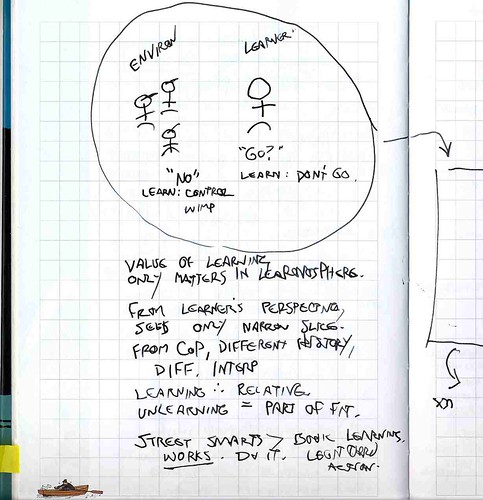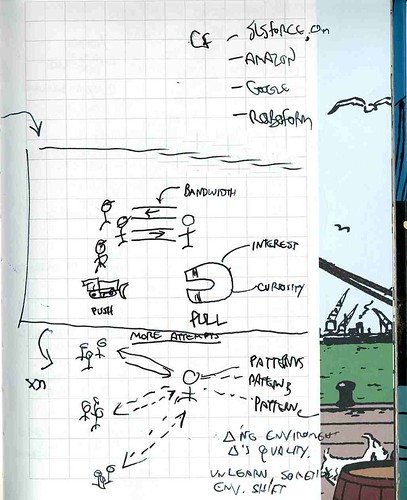Saturday, July 02, 2005
Watch Jay Learn
Yesterday I told a bunch of friends that I was spending my time working on my book on Informal Learning. How far along are you? they asked. I replied that it's too early to tell; I'm collecting stories. Last night an inner voice told me I'd better start framing my point of view.
The steps I take to discover and describe a new point of view are hardly logical. If you talked with the inner voice in my head, it would tell you that I'm under the influence of ideas from blogs, books, conversations, interviews, and things that float by. At times I think of myself as a blue mussel, gaining nourishment from the water that washes over me, only this time it's ideas not plankton and the sea is comprised of words, images, and emotions.
On Wednesday an idea came to me while sitting al fresco at an Italian restaurant in San Francisco awaiting my family. If corporations are legally persons and it's hip to say they're living organisms, how to they compare to humans? Both think they're more in control than they really are.
I've been reading The Only Sustainable Advantage, On Becoming an Artist, A Whole New Mind, City of Bits, and Learning by Doing, and concepts from all of them dart in and out of my consciousness. Ellen Langer's On Becoming an Artist reinforced my feeling that if something's worth doing, it's worth doing artistically: better to be mindful than mindless. The Only Sustainable Advantage has be re-evaluating my core: I've never leveraged by speaking voice; at the end of the day, I'm a persuasive writer. A Whole New Mind reminds me that culture is always evolving, this time toward individual freedom. City of BIts lets me decouple the form and function of architecture so I can think about new configurations. And Learning by Doing is reminding me to speak in my own voice and to tell it like it is. My friend Clark offers a model of learning that's clear, and I want to do the same, although his model doesn't work for me. So these ideas are swirling around when I receive an email newsletter from my pal Gary Dickelman that talks about the centernnial of Einstein's greatest year of discovery.
The key to unlocking relativity was a thought experiment. (Einstein was sort of low-tech.) What would it look like if you were traveling at the speed of light? More specifically, if one were riding a streetcar from the Basel clocktower at the speed of light, what would you see? Ah ha, the hands of the clock would appear to be frozen in time because more recent images would never catch up with you.
So I wondered what learning might look like to an outside observer. WIthout other people around -- context -- there's no measurable learning, so into my journal, I drew a stick-figure representing a learner and a group of three stick figures representing local community. I imagined a dialog wherin the learner asks a question, and someone from the community shuts him down. Each learn something. Something different. Learning is indeed relative.
Here's the page:

The next day I doodled a bit more. To be able to describe what makes learning easy or hard, I needed something to tie the learner to the group and vice-versa. I also tried to squeeze motivation into the picture. The learner is drawn to things that can help her out and be fun at the same time. (I drew a big magnet, marking it "pull.") The group is on the receiving end, too, but the main activity is pushing information at the learner; I added a bulldozer to the drawing.
A few minutes later I had a conceptual breakthrough. Every learner participates in multiple communities. His knowledge is worth more in one community than another. And time changes everything. Even if I could remember it, my COBOL programming skills wouldn't be worth much today. As it is, time and lack of practice have eroded all memory of COBOL; I've autonomically unlearned it.

Last night after supper I started a PowerPoint presentation and redrew the doodles. I use PowerPoint as a scratch pad for ideas. The graphics tools are simple and fast. Sometimes I have to take something into my regular drawing program (PaintShop), tweak it, and put it back into PowerPoint. I'll move slides around until I get a pattern that tells a story. I grab pictures from the internet with Google images as placeholders while I construct slides.
After an hour or so of grabbing images and trying different arrangements, I had come up with a simple model which would enable me to continue exploring learning. Dustin Hoffman became my prototypical learner; it seemed appropriate to have the naive Graduate involved in this.

For the last couple of months, I've been thinking about what I call the "augmented learner." I have the distinction of being a member of the last class at Harvard Business School that was not allowed to use calculators during exams. Today's students are encouraged to bring calculators. This only makes sense. Now that they're affordable, anyone who wants to can use a calculator in her work, so that's what the exams should test: the performance of the student with a calculator. So calculators are okay.
What about cell phones? Shouldn't the MBA student be able to throw out a lifeline to his network? And how about the internet? Shouldn't the student be able to query the net during a test? Real life is an open-book exam, so why should schools' simulations follow suit? Everything has a lifecycle.
The evolving PowerPower slides got me to thinking about Augmented Connections and an Augmented Environment. Nothing's standing still.
My last slide pictures a three-wheel slot machine. In place of Bells, Cherries, and Bars, it has Learning, Connections, and Community. That's as far as my thinking has gone. I'll get back to it, perhaps this evening.
The steps I take to discover and describe a new point of view are hardly logical. If you talked with the inner voice in my head, it would tell you that I'm under the influence of ideas from blogs, books, conversations, interviews, and things that float by. At times I think of myself as a blue mussel, gaining nourishment from the water that washes over me, only this time it's ideas not plankton and the sea is comprised of words, images, and emotions.
On Wednesday an idea came to me while sitting al fresco at an Italian restaurant in San Francisco awaiting my family. If corporations are legally persons and it's hip to say they're living organisms, how to they compare to humans? Both think they're more in control than they really are.
I've been reading The Only Sustainable Advantage, On Becoming an Artist, A Whole New Mind, City of Bits, and Learning by Doing, and concepts from all of them dart in and out of my consciousness. Ellen Langer's On Becoming an Artist reinforced my feeling that if something's worth doing, it's worth doing artistically: better to be mindful than mindless. The Only Sustainable Advantage has be re-evaluating my core: I've never leveraged by speaking voice; at the end of the day, I'm a persuasive writer. A Whole New Mind reminds me that culture is always evolving, this time toward individual freedom. City of BIts lets me decouple the form and function of architecture so I can think about new configurations. And Learning by Doing is reminding me to speak in my own voice and to tell it like it is. My friend Clark offers a model of learning that's clear, and I want to do the same, although his model doesn't work for me. So these ideas are swirling around when I receive an email newsletter from my pal Gary Dickelman that talks about the centernnial of Einstein's greatest year of discovery.
The key to unlocking relativity was a thought experiment. (Einstein was sort of low-tech.) What would it look like if you were traveling at the speed of light? More specifically, if one were riding a streetcar from the Basel clocktower at the speed of light, what would you see? Ah ha, the hands of the clock would appear to be frozen in time because more recent images would never catch up with you.
So I wondered what learning might look like to an outside observer. WIthout other people around -- context -- there's no measurable learning, so into my journal, I drew a stick-figure representing a learner and a group of three stick figures representing local community. I imagined a dialog wherin the learner asks a question, and someone from the community shuts him down. Each learn something. Something different. Learning is indeed relative.
Here's the page:

The next day I doodled a bit more. To be able to describe what makes learning easy or hard, I needed something to tie the learner to the group and vice-versa. I also tried to squeeze motivation into the picture. The learner is drawn to things that can help her out and be fun at the same time. (I drew a big magnet, marking it "pull.") The group is on the receiving end, too, but the main activity is pushing information at the learner; I added a bulldozer to the drawing.
A few minutes later I had a conceptual breakthrough. Every learner participates in multiple communities. His knowledge is worth more in one community than another. And time changes everything. Even if I could remember it, my COBOL programming skills wouldn't be worth much today. As it is, time and lack of practice have eroded all memory of COBOL; I've autonomically unlearned it.

Last night after supper I started a PowerPoint presentation and redrew the doodles. I use PowerPoint as a scratch pad for ideas. The graphics tools are simple and fast. Sometimes I have to take something into my regular drawing program (PaintShop), tweak it, and put it back into PowerPoint. I'll move slides around until I get a pattern that tells a story. I grab pictures from the internet with Google images as placeholders while I construct slides.
After an hour or so of grabbing images and trying different arrangements, I had come up with a simple model which would enable me to continue exploring learning. Dustin Hoffman became my prototypical learner; it seemed appropriate to have the naive Graduate involved in this.

For the last couple of months, I've been thinking about what I call the "augmented learner." I have the distinction of being a member of the last class at Harvard Business School that was not allowed to use calculators during exams. Today's students are encouraged to bring calculators. This only makes sense. Now that they're affordable, anyone who wants to can use a calculator in her work, so that's what the exams should test: the performance of the student with a calculator. So calculators are okay.
What about cell phones? Shouldn't the MBA student be able to throw out a lifeline to his network? And how about the internet? Shouldn't the student be able to query the net during a test? Real life is an open-book exam, so why should schools' simulations follow suit? Everything has a lifecycle.
The evolving PowerPower slides got me to thinking about Augmented Connections and an Augmented Environment. Nothing's standing still.
My last slide pictures a three-wheel slot machine. In place of Bells, Cherries, and Bars, it has Learning, Connections, and Community. That's as far as my thinking has gone. I'll get back to it, perhaps this evening.
